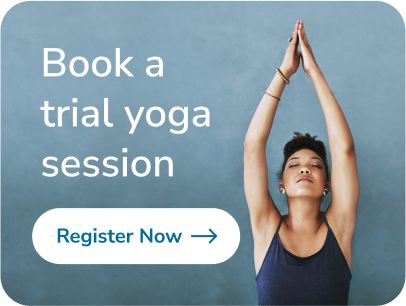Written by Dr. Bhavya
Medically reviewed by Dr Godmi Tresa
Updated on February 05, 2025
Embracing the Power of Stillness: Relax, Rejuvenate, and Recharge with Restorative Yoga
Restorative Yoga has gained immense popularity in today's fast-paced and stress-filled world as a refuge from chaos. As people yearn for solace and a break from the constant hustle, this practice has become a sanctuary that nurtures both body and mind. With its emphasis on deep rest, stress reduction, and overall well-being, Restorative Yoga serves as a much-needed antidote to society's glorification of busyness. It creates a space to slow down, replenish energy, and rediscover inner peace, providing much-needed respite from the demands of daily life!
In this blog, you will learn about Restorative Yoga and how it can benefit your body and mind.
Jump to section
- Restorative Yoga: Why and How
- So, what makes restorative Yoga stand out from other dynamic yoga styles?
- The benefits of Restorative Yoga are:
- Physical Benefits of Restorative Yoga: Activate the Key to Wellness
- Did you know that Restorative Yoga supports enhanced circulation and detoxification?
- Restorative Yoga: Finding Serenity and Embracing Tranquility
- Exploring Restorative Yoga Poses: A Guide to Plan Your Happiness Project
- Supported Child's Pose (Balasana):
- Supported Bridge Pose (Setu Bandha Sarvangasana):
- Legs-Up-The-Wall Pose (Viparita Karani):
- Reclining Bound Angle Pose (Supta Baddha Konasana):
- Restorative Yoga Classes: Finding Your Sanctuary
- How to Find Local Restorative Yoga Classes and Studios?
- Why is the communication between the practitioner and instructor important?
- Why is Finding a Qualified Instructor Influential?
Restorative Yoga: Why and How
Restorative Yoga is a gentle and soothing practice that focuses on relaxation, rejuvenation, and healing and embraces rest, support, and surrender. It allows you to experience profound therapeutic benefits.
So, what makes restorative Yoga stand out from other dynamic yoga styles?
In contrast to the dynamic nature of other yoga styles, Restorative Yoga embraces a gentle approach by holding poses for extended periods, typically lasting between 5 to 20 minutes. This allows the body to fully surrender into each pose, supported by props such as blankets, bolsters, and blocks that provide optimal comfort and stability.
Restorative Yoga stands out as it creates a haven for individuals to relax, renew, and recharge. It contrasts vigorous yoga practices by inviting practitioners to slow down, release tension, and tap into a deep sense of tranquillity.
The benefits of Restorative Yoga are:
- This nurturing practice promotes the release of physical and mental tension.
- Calms the nervous system.
- Encourages the body's natural healing processes.
- It emphasises the art of relaxation and encourages practitioners to find stillness.
Restorative yoga practice prioritises self-care, self-compassion, and honouring bodily boundaries, fostering deep introspection. In contrast to vigorous Yoga, Restorative Yoga becomes a sanctuary for tranquillity, rejuvenation, and profound self-connection. It allows practitioners to recharge, find inner healing, and embark on a transformative journey.
Physical Benefits of Restorative Yoga: Activate the Key to Wellness
Restorative Yoga is renowned for its remarkable capacity to induce relaxation and alleviate stress. Activating the body's relaxation response through supported poses and deep breathing promotes deep rest and restoration. Studies and testimonials have consistently shown its effectiveness in reducing stress, anxiety, and tension while enhancing overall well-being.
Restorative Yoga gently stretches and lengthens muscles, improving flexibility and range of motion.
In addition to this, holding poses for extended periods with the support of props allows muscles to release tension and gradually elongate.
Some restorative poses that promote flexibility include:
- Supported Forward Fold
- Reclining Bound Angle Pose
- Supine Spinal Twist.
Get in touch with our yoga experts to learn these poses and ins your peace with Restorative Yoga.
Did you know that Restorative Yoga supports enhanced circulation and detoxification?
The gentle nature of this nurturing practice encourages blood flow and lymphatic drainage, aiding in removing toxins from the body. Improved circulation also promotes cardiovascular health.
Certain restorative poses, such as:
- Legs-Up-The-Wall Pose
- Supported Bridge Pose can specifically help circulation and facilitate detoxification processes.
While individual experiences may vary, the growing body of scientific research and personal accounts strongly support the physical benefits of Restorative Yoga.
Restorative Yoga: Finding Serenity and Embracing Tranquility
From its ability to induce deep relaxation and promote better sleep to cultivating mindfulness, Restorative Yoga offers a range of mental and emotional benefits.
Triggers Relaxation Response
Restorative Yoga calms the mind, soothes the nervous system, and triggers the body's relaxation response.
Improves Sleep Quality
Deep relaxation in Restorative Yoga manages stress and improves overall well-being and sleep quality. It offers a dedicated space to unwind, release tension, and find inner peace, promoting rest and rejuvenating sleep.
Better Control of Mood and Emotional Balance
Moreover, Restorative Yoga has a positive impact on mood and emotional balance. The practice stimulates the release of endorphins, natural feel-good hormones that uplift the spirit and reduce feelings of anxiety and depression.
Restorative Yoga reduces cortisol levels, the stress hormone linked to negative emotions and physiological stress responses. By fostering calmness and relaxation, it cultivates an environment conducive to emotional well-being and mental balance.
Cultivating Mindfulness and Self-Awareness
Restorative Yoga encourages cultivating present-moment awareness and self-reflection through breath awareness and meditation techniques. This heightened mindfulness improves stress management and emotional resilience as individuals gain a deeper understanding of their thoughts, emotions, and reactions.
Exploring Restorative Yoga Poses: A Guide to Plan Your Happiness Project
Here are the super-4 Restorative Yoga poses to recharge the inner you.
Supported Child's Pose (Balasana):
- Start by placing a bolster or a stack of folded blankets lengthwise on your mat.
- Kneel and bring your big toes together while sitting back on your heels and separate your knees wider than hip-width apart.
- Exhale and lower your torso onto the bolster, resting your forehead on the support.
- Extend your arms forward or rest them alongside your body. Let your hips sink towards your heels, and surrender to the gentle stretch.
- Stay in this pose for 5-10 minutes, focusing on deep, slow breaths.
- To modify, use additional props to support your chest, head, or thighs.
Supported Bridge Pose (Setu Bandha Sarvangasana):
- Lie down on your mat with your knees bent and feet hip-width apart.
- Place a bolster or a folded blanket under your sacrum, supporting your lower back.
- Press your feet into the mat to lift your hips, and slide the bolster or blanket further under your sacrum.
- Rest your arms alongside your body with your palms facing up. Close your eyes and allow your body to relax into the support.
- Stay in this pose for 5-10 minutes, breathing deeply.
- To modify, use additional props such as blocks or pillows to support your back or elevate your hips.
Legs-Up-The-Wall Pose (Viparita Karani):
- Sit with your right side against a wall, then gently lie down on your left side, swinging your legs up the wall.
- Adjust your distance from the wall so that your sitting bones are touching or close to it.
- Extend your legs up, allowing your heels to rest against the wall. Relax your arms alongside your body with your palms facing up.
- Close your eyes and breathe deeply, feeling the gentle stretch in your legs and the grounding support of the wall.
- Stay in this pose for 10-15 minutes.
- Place a folded blanket under your hips or a rolled-up towel under your neck for additional support.
Reclining Bound Angle Pose (Supta Baddha Konasana):
- Sit on your mat with your knees bent and feet together, allowing your knees to fall open to the sides.
- Lie back and support your knees with blocks or folded blankets to find a comfortable hip opening.
- Rest your arms alongside your body with your palms facing up.
- Close your eyes and take slow, deep breaths, surrendering to the gentle opening of the hips and inner thighs.
- Stay in this pose for 5-10 minutes.
- For support, you can place additional props under your knees, hips, or head.
Listen to your body, adjust the props for proper alignment, and modify the poses to suit your comfort level. As you surrender into the supported postures, allow yourself to relax and deeply embrace each pose's rejuvenating benefits.
Restorative Yoga Classes: Finding Your Sanctuary
Attending restorative yoga classes can provide a sanctuary amidst the demands of daily life, offering a dedicated space for relaxation, rejuvenation, and self-care.
How to Find Local Restorative Yoga Classes and Studios?
To find local Restorative yoga classes and studios, consider exploring community centres, yoga studios, or wellness centres. You can also search online directories or use search engines with specific keywords such as "restorative yoga classes near me" or "restorative yoga studios in [your location]." Reading reviews or seeking recommendations from friends and fellow practitioners can also help find reputable instructors and welcoming spaces.
Connect with Nirva Yoga experts to get your individualised sanctuary for restorative Yoga.
Why is the communication between the practitioner and instructor important?
When attending a restorative yoga class, it's essential to communicate any injuries or limitations to the instructor beforehand. This way, they can provide appropriate modifications and ensure your safety during the practice. Remember that restorative Yoga is a personal journey, and each class may offer a unique experience. Be open to exploring different teachers and styles to find the right fit.
Why is Finding a Qualified Instructor Influential?
These classes provide an opportunity to deepen your practice and experience the full benefits of restorative Yoga under the guidance of a qualified instructor. A knowledgeable and experienced teacher ensures a safe and effective practice.
Conclusion
Restorative Yoga offers numerous benefits for the body and mind. It promotes deep relaxation, releases tension, and improves flexibility. It supports enhanced circulation, detoxification, and overall well-being. Mentally, restorative Yoga cultivates mindfulness, self-awareness, and emotional balance. It uplifts mood, reduces anxiety, and nurtures your entire being. Experience the profound benefits of Restorative Yoga, enhance well-being, and embark on a journey of healing and restoration.
Frequently Asked Questions
Restorative Yoga is a gentle practice focused on relaxation and healing. It involves holding supported poses for extended periods using props like blankets, bolsters, and blocks. Unlike dynamic styles, restorative Yoga prioritises deep relaxation and tension release, promoting tranquillity.
Restorative yoga benefits both body and mind. It promotes deep relaxation, reduces stress and anxiety, improves sleep, and enhances well-being. It gently stretches muscles, improves flexibility, and supports circulation and detoxification. Mentally, it cultivates mindfulness and emotional balance.
Restorative Yoga is inclusive and suitable for individuals of all fitness levels and experiences. It respects each person's unique body and promotes self-care and self-compassion. With props and modifications, poses can be tailored to individual needs, making it accessible for beginners and those with physical limitations or injuries.
Incorporating restorative Yoga into your daily routine brings balance and calm. Set aside dedicated time and space, starting with a few minutes and gradually increasing duration. Learn poses and sequences from online resources, books, or classes. Listen to your body, breathe deeply, and surrender to each pose. Consistency is critical, making restorative Yoga a regular part of your self-care routine for optimal benefits.
Dr. Bhavya
She offers a holistic approach to healing that focuses on the interplay between the body, mind, and spirit. Her expertise in these areas allows her to provide comprehensive care for various conditions, from musculoskeletal disorders to stress-related illnesses. She is dedicated to empowering women to take control of their health and well-being. Her proactive approach to healthcare emphasises the importance of preventive measures and natural remedies.

8 Effective Face Yoga Exercises to Reduce Marionette Lines Naturally
15 Foods to Avoid with Gallbladder Issues & Best Foods for Gallbladder Health
Understanding Your Gut Type and Its Impact on Health
4 Simple Ways to Manage Hot Flashes at Work
3 Stretching exercises for desk workers - Get Relief from Neck, Back and Wrist Pain









